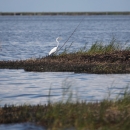The U.S. Department of the Interior, acting through the U.S. Fish and Wildlife Service (USFWS) and the State of Missouri, acting through the Missouri Department of Natural Resources (MoDNR), acting in their capacity as natural resource trustees (Trustees) have prepared this Final Restoration Plan and Environmental Assessment (RP/EA) to evaluate and select restoration actions along the Big River located in southeastern Missouri. The restoration actions are meant to compensate the public for natural resources injured and ecological services lost due to releases of hazardous substances, including heavy metals at and from mines, mills, smelters, and tailings impoundments of the Big River Mine Tailings and Southwest Jefferson County Lead Mine Superfund Sites (collectively called “Big River” or “Superfund Sites”) within the Old Lead Belt of southeast Missouri. Pursuant to applicable regulations, the Trustees have initiated natural resource damage assessment and restoration (NRDAR) processes at different sites throughout the Southeast Missouri Lead Mining District (SEMOLMD or SEMO) and have successfully recovered monetary damages to use to restore impacted natural resources and their services. These restoration actions analyzed and selected herein complement planned response actions by the U.S. Environmental Protection Agency (USEPA) at the Superfund Sites.
For over a century, heavy metals, including, but not limited to lead and zinc were mined, milled, and smelted in the Old Lead Belt. Lead mining, milling, and smelting no longer occur in the Old Lead Belt, though past and ongoing releases of hazardous substances into nearby soils, sediments, and surrounding waters, in particular, the Big River watershed, have led to natural resource injuries. Several natural resources, including surface water, sediments, geologic resources, fish, mussels (including species listed pursuant to the Endangered Species Act “ESA”), crayfish, and migratory birds, have been exposed to and adversely affected by hazardous substances released from the mining associated facilities in the Big River watershed (Allert et al. 2010, Besser et al. 2009, McKee et al. 2010, and Roberts et al. 2016). Big River sediment and floodplain soils are contaminated with lead, zinc and cadmium for over 100 miles below the first large industrial scale lead mining and milling facility in Leadwood, St. Francois County, MO. (Pavlowsky et al.2010; see Figure 1 below). Contaminated floodplain soils have been shown to have adverse effects on migratory songbirds and plant communities. (Beyer et al. 2013; Struckhoff et al. 2013).



